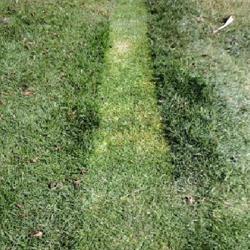- 09 - 12 - 2022
- Seasonal care Turf News
Lawn Thatching Explained
Does your lawn look worse after a mow? Are there circular spots of dry, frayed grass after mowing? I’m sorry to tell you but it’s highly likely you have thatch. Don’t be alarmed, you don’t need to see a GP. The cure is close at hand if you have a lawn mower.
Thatch is a build-up of dead grass leaves, stolons, and rhizomes in your lawn. It can leave your lawn looking unkempt after it is mown and reduces water infiltration making the lawn less tolerant to drought.

How to Treat Lawn Thatching?
To solve this issue, you need to head to the shed and get out the mower. You are about to butcher your lawn by giving it the equivalent of a skinhead haircut, better known as scalping.
Scalping turf to remove thatch can be achieved by setting the mower as low as possible and using a catcher on the mower. Always remove the clippings when dethatching. If your mower failed to collect the clippings in the scalping process, you can either rake them up or set the mower on a slightly higher setting than you used to scalp the lawn and use the catcher to collect them in a second pass mow.
When to Dethatch Grass in Australia?

In the southern Australian states, thatch removal in warm-season grasses is best carried out from late October to early December.
Before October, grass from the warm season is still recovering from winter and developing new shoots and energy stores in the root system as well as producing new roots, rhizomes, leaves, and stolons. Scalping at this early stage will result in a slow recovery and provide bare areas for weed seed to develop in. Scalping a lawn in spring is ideal. You should wait until the weather warms up and soil temperatures have risen to 16°C. Once this temperature is attained, scalp the lawn as much as possible. The ideal time to do this in Victoria is from early November (Melbourne Cup Week) through until the end of January. This rule applies to Couch grass (TifTuf, Nullarbor, and Santa Ana varieties) and Kikuyu varieties, such as Eureka.
Sir Walter Buffalo should not be scalped back to bare earth as it will not recover. Stolons and some leaf material need to be left in place for Buffalo lawns. The same applies to Blue Couch (Digitaria diacetyla).
To dethatch Buffalo varieties such as DNA Certified Sir Walter and Blue Couch lawns, use a rake to remove dead leaf material. If the rake is used aggressively, it will have a similar effect to moderate low mowing. Discard the dead vegetative material after raking.
What to Do Once Lawn is Dethatched?
Feed the lawn immediately after scalping with Lawn Food Fertiliser and irrigate. The use of a wetting agent at this stage will also benefit water penetration through what is probably a hydrophobic (water-repelling) surface layer.
A scarifier (dethatcher) machine is also useful to remove thatch. Couches and Kikuyu will benefit from running a scarifier through them in the warmer months prior to late January. Do not scarify or scalp after January. Scarifiers can be rented. Wait for the lawn to recover from the close mowing/dethatching process before scarifying.
Coring is sometimes suggested as a means of thatch removal. It is not as effective as the scalping/dethatching process because only 8-12 percent of the surface matt is removed with a conventional core pass. Coring is used to open the surface to oxygenate the profile and “unseal the surface” prior to topdressing. It also provides an entry point for topsoil to get into the old soil profile when topdressed immediately after coring.
Removing lawn clippings helps slow thatch development and we encourage this practice. If possible, use a catcher on your mower.
Do not scalp the lawn in its first spring season if it was laid in late autumn or winter. It is still a baby in its lifespan and needs to develop a strong root system to get it through its first summer.
Following the thatch removal process, your lawn will look brown. It will recover quickly and look perfect within three to four weeks and the benefits of the scalping will show throughout summer.
Should you need professional help with dethatching your lawn, Anco Turf can help you with the process. Contact us at 1800 010 110 to speak with a turf maintenance specialist.
A video of the dethatching process can be seen below.
Related Posts:
How to Lay Turf – Step by Step Guide

 0
0








 Back
Back
